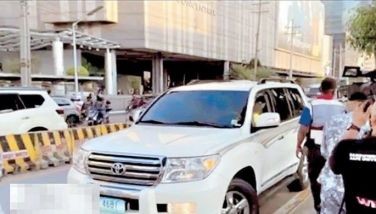No need to reinvent the wheel

As early as in 2013, the Japan International Cooperation Agency (JICA) crafted a study called Transport Infrastructure Development Roadmap for Mega Manila to help ease worsening congestion in the metropolis and at the same time to attract more investments.
The Mega Manila Transport Dream Plan proposed then by JICA will help the Philippines save P2.4 billion per day, the estimated economic and financial losses due to traffic congestion. It cited strategies to reduce traffic congestion significantly before it impacts the lower-income group who will be hardest hit when congestion worsens by 2030.
The JICA study concluded that without intervention, traffic costs will likely increase to P6 billion a day, from today’s P2.4 billion.
Preliminary analysis in the study showed that the average low-income group households have to spend no less than 20% of their monthly household income for transport. Without intervention, traffic demand will likely increase by 13% by 2030, and transport cost will be 2.5 times higher.
The JICA’s proposed roadmap was part of a technical assistance project to the National Economic Development Authority (NEDA). It outlined short-term and long-term components, citing the need to boost infrastructure development. This included construction of new gateway airports and seaports, improved road networks and expressways, integrated urban mass-transit network in Metro Manila, and road-based public transport modernization.
The study was done by JICA in close coordination with the Department of Transportation and Communications (DOTC); Department of Public Works and Highways (DPWH); Metro Manila Development Authority (MMDA); and other relevant agencies.
According to this JICA Roadmap, demand for mass transit in Mega Manila will likely reach 7.4 million passengers a day by year 2030. Today, government estimates place it at 71% of trips in Metro Manila rely on public utility buses and jeepneys. This is not to mention flooding in low-lying parts of Metro Manila that also contribute to traffic jams.
JICA Philippines chief representative Takahiro Sasaki was quoted saying by the NEDA press release the Roadmap can help spur long-term investments in areas such as manufacturing, agro-based industries, services, and tourism among others, and further accelerate industrial development in the Clark-Subic and Batangas-Lipa areas.
With the envisioned better north-south connectivity and appropriate hierarchy of different transportation modes such as roads, railways, and other mass transits, the Roadmap hopes to achieve the “Dream Plan” to have a modern, affordable and a well-coordinated and integrated transport system. The final report included preliminary studies for “Mega Manila Subway Project” and “New Ninoy Aquino International Airport Project.”
One of the innovations proposed in the study was implementing a so-called “Intelligent Transport System” or ITS to maximize the city’s existing road capacity. The ITS, the study noted, includes better traffic engineering and management that requires geometric improvements, pedestrian facilities, traffic surveillance, accident prevention, traffic safety education, and traffic enforcement.
An example of ITS in the study requires a signal control system, travel time prediction, road maintenance, “intelligent parking,” incident detection, and bus scheduling assistance among others. Actually, these proposed solutions are common sense which seemed to be not common among our motorists, passengers and pedestrians as well.
By putting modern technology and discipline into traffic management, the JICA study said the Philippines can make better use of available infrastructure. In terms of social impact, the JICA study said with interventions, it is likely that the average transport fare of P42 by a commuter today will be reduced to P24 due to improved connectivity and common fare. Travel time is also likely to be reduced from 80 minutes per trip to 31 minutes.
The JICA Roadmap was originally expected to be finished in August 2013 but it was extended to March 2014 based on the request from the Philippine government headed by now outgoing President Benigno “Noy” Aquino III. In September 2014, NEDA announced that the NEDA Board, chaired by President Aquino, approved the “Roadmap for Transport Infrastructure Development for Metro Manila and Its Surrounding Areas.”
Nothing was heard of about the JICA Roadmap study after it came out. In the few days from now, President Aquino steps down from office. Newly elected President Rodrigo Duterte will inherit, among other national concerns, the traffic congestion problem now at “crisis” level, necessitating the proposed use of emergency powers to nip it in the bud.
Meeting for the first time with businessmen yesterday in Davao City a few days before he officially assumes office, President Duterte renewed his vow to improve mobility in Metro Manila as one of the ways to sustain economic growth that would benefit all Filipinos all over the country.
Incoming Justice Secretary Vitaliano Aguirre II disclosed he received last Monday night the draft bill seeking the grant of emergency powers to President Duterte. It was drafted by Duterte’s legal team headed by incoming Chief Presidential Legal Counsel Salvador Panelo. The bill, if President Duterte approves it, will be submitted as urgent administration measure as soon as the 17th Congress opens on July 25.
The proposed emergency powers would allow the national government to supersede injunction orders against measures that could resolve the traffic crisis. The emergency powers being mulled will be effective for as long as two years.
With the additional powers, the government can also overrule existing local government ordinances; favor direct contracting over public biddings for transportation-related projects; open private subdivision roads to traffic; and remove transport terminals and “tiangges” or vendors who peddle their wares on busy roads and highways.
The final report of the Roadmap is available in JICA’s online library. The Cabinet and economic managers of President Duterte can just update the JICA Roadmap while waiting for the 17th Congress to decide on the proposed emergency powers to supposedly avert the looming “traffic crisis” in Metro Manila. Hence, there is no need to reinvent the wheels to make the flow of traffic smoother and faster in Metro Manila.
- Latest
- Trending




























